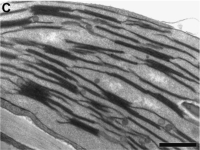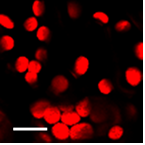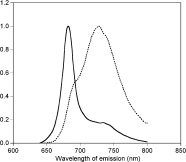In vivo spectroscopy of single chloroplasts
This research topic is a cooperation project between our group and The Center for Plant Molecular Biology (ZMBP) in Tübingen.
Chloroplasts are small (4-6 µm), oval shaped cell organelles which are stored in large amounts in plant cells and all organisms performing photosynthesis. The chloroplasts' thylakoid membranes accommodate protein complexes that are involved in the light reaction of photosynthesis.



Chloroplast emission spectroscopy. Left: Typical TEM of Arabidopsis thaliana chloroplast with visible thylakoid membranes. Scale bar 2 µm. Image courtesy of Hyman, S., Jarvis, R.Paul, Chloroplast Research in Arabidopsis, p.126, 2011, Humana Press. Middle: Fluorescence microscopy image of Nicotiana tabacum chloroplasts. Scale bar 10 µm. Right: putative PSII (straight line) and PSI (dotted line) fluorescence emission spectra in native form for plants (Pedrós et al., Photochem. Photobiol. Sci., 2008,7, 498-50)
Photosystem I (PSI), Photosystem II (PSII) and their light harvesting complexes (chlorophyll a, chlorophyll b and carotenoids) are ultimately responsible for the conversion of the sunlight's energy into energy rich molecules like glucose.
Even though photosynthesis is a highly efficient process, a fraction of the absorbed energy is being emitted as fluorescence, which can be detected by using spectro-microscopic techniques e.g. confocal emission spectroscopy. Supported by high resolution imaging, we can therefore investigate spectra of single chloroplasts in their native tissue environment at ambient temperatures in vivo. By analyzing the emission ratio of the photosystems (PSI/PSII), we acquire detailed information about the state of the photosynthetic machinery. Investigating single chloroplasts also allows for a statistical approach to analyze ratio distributions, which would be hidden in bulk measurements.
Adverse environmental conditions like heat, cold, drought or salinity of the soil can impair the normal metabolic processes and the photosynthesis process. Some stress responses are triggered quickly within a few minutes while others peak hours or days later. The adaptation to external stressors necessitates adjustments of the plants' metabolism to ensure its survival. Measuring the resulting changes in the PSI/PSII emission ratio, we are able to investigate these stress responses on a microscopic scale, long before the plant phenotype alters.
